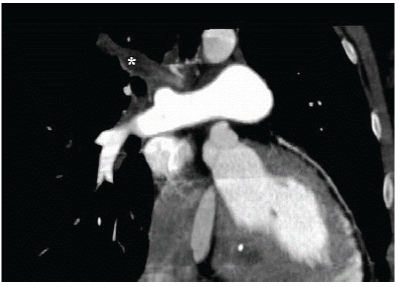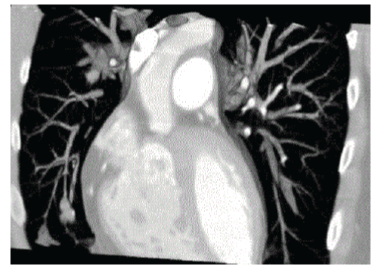Case Report Open Access
Pulmonary Hypertension Secondary to Cardiac Hydatid Cyst Embolism
Mehmet Sait Menzilcioglu*Department of Radiology, Gazi University, Bahçelievler, Ankara, Turkey
- Corresponding Author:
- Mehmet Sait Menzilcioglu
Department of Radiology
Gazi University, Bahçelievler
Ankara-06100, Turkey
Tel: +90-3124844928
Fax: +90-3124844929
E-mail: dr.m.sait@hotmail.com
Received May 06, 2015; Accepted June 24, 2015; Published June 26, 2015
Citation: Menzilcioglu MS (2015) Complication of Cardiac Hidatic Cyst. OMICS J Radiol 4:190. doi: 10.4172/2167-7964.1000190
Copyright: ©2015 Menzilcioglu MS. This is an open-access article distributed under the terms of the Creative Commons Attribution License, which permits unrestricted use, distribution, and reproduction in any medium, provided the original author and source are credited
Visit for more related articles at Journal of Radiology
Abstract
Hydatid pulmonary embolism is an uncommon condition. Pulmonary hypertension secondary to embolism is even rare. Cardiac hydatid cysts may stay asymptomatic for a long time until they reveal themselves with serious outcomes such as cerebral and pulmonary embolization, heart block and valvular obstruction. Pulmonary embolism is due to iatrogenic or spontaneous perforation of the cardiac hydatid cyst. Awareness of this condition and its radiological findings is important to prevent further potentially fatal complications. Herein, we report a case of cardiac hydatid cyst causing pulmonary hypertension secondary to pulmonary arterial embolism.
| Introduction |
| Cardiac hydatidosis (CH) is a rare parasitic disease caused by larval forms (metacestodes) of the genus Echinococcus. It constitutes approximately 0, 02-2% of all cases of human hydatidosis [1]. Hydatid pulmonary embolism is a complication of CH that generally occurs after an iatrogenic or spontaneous rupture of the right ventricular or right atrial hydatid cyst or from systemic circulation [2-5]. Before the introduction of cross-sectional imaging techniques the diagnosis was based on clinical and laboratory findings. Echocardiography is a noninvasive effective tool for the diagnosis of the CH. But it is not always suitable for the detection of pulmonary cysts. In this condition Computed Tomography (CT) or Magnetic Resonance Imaging (MRI) may aid in the diagnosis [1,6]. We present a patient presenting with pulmonary hypertension due to pulmonary embolism of the CH that was detected with CT. |
| Case Report |
| 13-year-old female admitted to the paediatric cardiology department complaining of dyspnoea appearing with effort. Two years ago she had been operated because of right ventricular hydatid cyst. |
| On physical examination, she was distressed. The blood pressure was 90/60 mm Hg; pulse 64 beat/min, temperature 36°C and respiration 24 breaths/min. On auscultation, there was 2/4 systolic ejection murmurs on mezocardiac area. |
| ¨Laboratory tests showed an increase in eosinophil count of 1100/mm3 (over 5%). Serologic tests of hydatid cyst were positive. Other parameters were normal. Spirometric examination revealed FVC: 85%, FEV1: 83%, FEV1/FVC: 100%, PEF: 85%. |
| Echocardiography was performed to demonstrate a residual cyst but no cardiac lesion was seen. Right ventricular dilatation and pulmonary hypertension was detected. Pulmonary artery pressure was 45-50 mm Hg. CT examination was performed which revealed total occlusion of the right upper lobe pulmonary artery. It was filled with a hypointense cystic material, which enhanced peripherally after contrast injection (Figure 1). |
| Moreover multiple cystic lesions in the pulmonary arteries in different locations were seen. The lesions were unevenly distributed and they were predominantly in the periphery of the lung. The lesions were also seen in pulmonary veins (Figure 2). A cyst was also seen at the level of right upper lobe pulmonary vein draining into the right atrium. With these findings the patient was diagnosed as pulmonary embolism of CH. Since hydatid disease was disseminated surgery could not be performed and Albendazole treatment was started. |
| Discussion |
| Cardiac cysts constitute 0.02%-2% of all hydatidosis cases [1]. The larva reaches the heart via coronary circulation. The left ventricle is the most frequently involved site (60%), followed by the right ventricle (15%) and the interventricular septum (9%) [5]. Rupture of a right ventricular cyst may result in pulmonary embolism, which is a rare cause of PAH. The embolism can occur spontaneously or during surgical removal of the hydatid cyst [2-5]. Direct spread of a visceral cyst to the pulmonary arteries via inferior vena cava and the right cardiac chambers is another possibility. The embryos reaching the lung change into small cysts and begin to grow. When the cysts are in an intra-arterial location it finally occludes the pulmonary arteries. But since the growing rate is slow it generally last long enough for adequate pulmonary perfusion through the bronchial arteries. Therefore these lesions may initially be asymptomatic. Compression of vital structures or interruption of blood circulation may cause symptoms in these patients [2]. In our case, the first symptom was progressive dyspnoea. Therefore a cardiac hydatid disease was suspected firstly. But on echocardiography PAH and enlargement of the right ventricle was seen. |
| Before the advent of CT and MRI clinical and laboratory tests were used to diagnose hydatid disease. But a definite diagnosis from ECG and chest X-ray was not possible [6]. The Casoni skin test, Weinberg reaction and the peripheral blood eosinophil count can be used but their value is low because of false negative results [6]. CT, MRI and echocardiography have the superior advantage of direct visualization of the emboli, pulmonary hypertension and parenchymal lesions, like in our case [1]. On CT, non-complicated cysts are usually seen as hypodense lesions, with the possible presentation of calcium on the periphery. Only the wall of the cyst enhances with the administration of intravenous contrast agent [1-4]. Our findings were in concordance with the previously reported cases. Hydatid cyst has a characteristic appearance on MRI. It is observed as an oval lesion that is hypointense on T1-weighted images (WI) and hyperintense on T2-WI. A peripheral hypointense ring on T2-WI represents the pericyst and is a typical finding. But it cannot always be detected [1-4]. In the present case conditions causing intraluminal defects such as pulmonary thromboembolism and primary arterial tumors should be excluded. The acute thromboembolic disease was excluded clinically, since the patient had no predisposing conditions, and there was no history of deep vein thrombosis in the lower legs [3]. On the other hand, the primary arterial tumor should be more aggressive, which was not the case in the follow-up [7]. Thus, the clinical presentation may be misleading and confused with other more frequent causes of pulmonary embolization; however, a combination of the clinical and radiological features and the medical history can lead to the correct diagnosis [1]. Once diagnosis has been established CT or MRI is effective for follow-up to search for recurrences or the formation of pseudoaneuryms [2-3]. |
| Although surgery combined with medical treatment may improve the prognosis, the treatment of this rare presentation should be individualized [2,4]. Surgical intervention can be complicated by rupture of the cyst, resulting in dissemination of the disease, anaphylactic shock, embolism, and pseudoaneurysm formation [4]. Albendazole is widely used and limited success has been reported. Rupture of a hydatid cyst of the lung during and after the cessation of albendazole treatment has been reported [8]. Therefore surgery has been advocated for intraarterial hydatid cysts. Our patient could not undergo surgery due to disseminated hydatid cyst therefore only Albendazole treatment was given. In cases of diffuse and severe involvement of the pulmonary arteries like that presented here, mortality is high [4]. |
References |
|
Figures at a glance
 |
 |
| Figure 1 | Figure 2 |
Relevant Topics
- Abdominal Radiology
- AI in Radiology
- Breast Imaging
- Cardiovascular Radiology
- Chest Radiology
- Clinical Radiology
- CT Imaging
- Diagnostic Radiology
- Emergency Radiology
- Fluoroscopy Radiology
- General Radiology
- Genitourinary Radiology
- Interventional Radiology Techniques
- Mammography
- Minimal Invasive surgery
- Musculoskeletal Radiology
- Neuroradiology
- Neuroradiology Advances
- Oral and Maxillofacial Radiology
- Radiography
- Radiology Imaging
- Surgical Radiology
- Tele Radiology
- Therapeutic Radiology
Recommended Journals
Article Tools
Article Usage
- Total views: 14694
- [From(publication date):
June-2015 - Aug 29, 2025] - Breakdown by view type
- HTML page views : 10076
- PDF downloads : 4618
